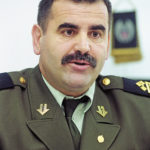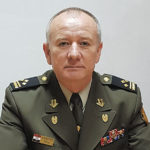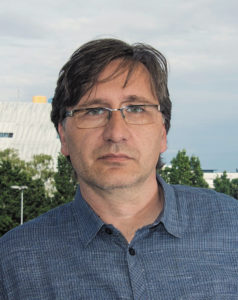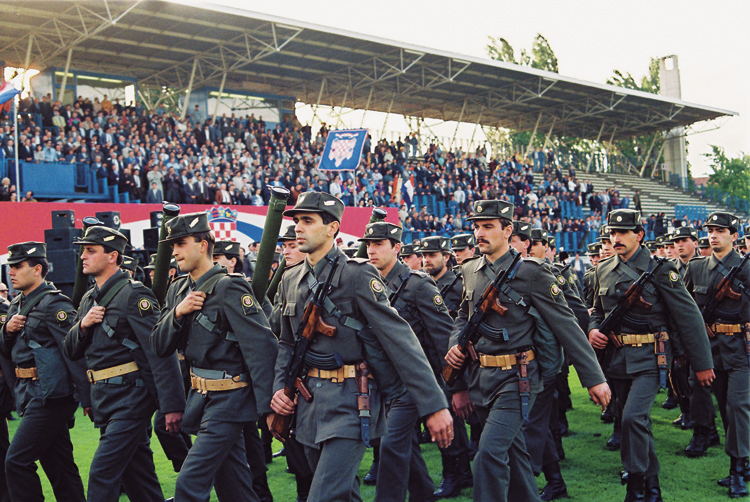The central marking of the Croatian Army and the Croatian Armed Forces Day and…
A 29-year history of the Croatian Army
The Croatian National Guard took an oath of enlistment before President Franjo Tuđman and the full stadium, and sent out a powerful message:”I SOLEMNLY SWEAR, STANDING READY TO SACRIFICE MY LIFE, TO PROTECT AND DEFEND MY HOMELAND CROATIA, ITS SOVEREIGNTY AND TERRITORIAL INTEGRITY AND ALL ITS CITIZENS!”
Conflicts around Pakrac, Bloody Easter and the massacre of the policemen at Borovo Selo grimly announced the fate of Croatia by late 1991. The first ones to counter the aggression in an organised manner, with arms, were the forces of the Croatian Ministry of the Interior and special police units (Croatia at the time was not allowed to establish military units). At the referendum on the independence of the Republic of Croatia held under the decision by President Franjo Tuđman on 19 May 1991 as many as 93.24 % voted in favour of sovereignty and independence of Croatia.
Meanwhile, the Croatian authorities were preparing legal foundations for the establishment of the Croatian National Guard as a professional military armed formation tasked with defence and policing and under the operational command by the Ministry of Defence. The Decision of 15 May 1991 enabled the establishment of four professional guard brigades of the Croatian National Guard, manned from the former active special police units.
The Yugoslav National Army was still present across Croatia, armed and located in barracks in towns, its intelligence services were active, peace was an illusion, and the atmosphere was tense. In such circumstances the Croatian leadership discretely established defence forces and intended to organise a formal-line up to reveal the existence of a Croatian military. It was a critical message – an encouragement and a sign that there were defending forces, a warning to the aggressor to consider the consenquences before striking and a message for the third that Croatia was taking responsibility for its own fate, future and independence. Many of the participants, who were busy practicing the posture, military marching and lining up were not quite sure what was going on; little more they knew than that something important was going to take place.
On 28 May 1991, when the first line-up of the National Guard was held at the NK Zagreb stadium in Kranjčevićeva – a day we mark today as the Day of the Armed Forces of the Republic of Croatia. Members of the units marched in front of President Franjo Tuđman, who presented the brigades of the Croatian National Guard with flags. In front of the crowded stadium and TV cameras the Croatian army recited the strong oath of allegiance:
“I SOLEMNLY SWEAR, STANDING READY TO SACRIFICE MY LIFE, TO PROTECT AND DEFEND MY HOMELAND CROATIA, ITS SOVEREIGNTY AND NTERRITORIAL INTEGRITY AND ALL ITS CITIZENS!”
Proud to be a part of the historic line-up
Some of the participants of the historic line-up at the FC Zagreb Stadium shared their recollections with “Hrvatski vojnik”, and some have remained serving in the Croatian Armed Forces to this day.
Zdravko Andabak, Brig. Gen. (Ret.) former member of the Special Police Unit (Special Purpose Unit of the Ministry of Defence) and of the 1st Guards Brigade “Tigrovi”
 A member of the famous “Tigrovi” from Rakitje Zdravko Andabak was highly aware of the circumstances in Croatia in May 1991.
A member of the famous “Tigrovi” from Rakitje Zdravko Andabak was highly aware of the circumstances in Croatia in May 1991.
“We witnessed to a series of incidents with tragic outcome: the first armed conflict in Pakrac, Bloody Easter at Plitvice, where our Unit lost the first victim – Josip Jović. The units’ members already predicted that the situation would escalate. The Croatian leaders were undertaking every effort to prevent bloodshed, but the aggressor was becoming more aggressive and had to be responded to. President Tuđman decided on the establishment of the Croatian National Guard as a formation to defend the Republic of Croatia, which had no right to have an army before dissociating from Yugoslavia”.
“The preparations for the establishment of the Croatian National Guard ran in secrecy and with high caution. The JNA was still present in the Croatian towns, and the intelligence services active and infiltrated at all levels. The plans for the establishment were discussed at secret meetings of confidential people. At first, only the commanders were more aware. At a meeting with the President a decision was made on the establishment of the Croatian National Guard, comprised of our unit as well, and I was assigned with preparing the members of the unit- the future guard brigade members- in an echelon at the line-up in public. Josip Lucić, the Commander of the 1st Guards Brigade “Tigrovi” conveyed the message to the Unit at Rakitje”.
What were the selection criteria for the line-up? What were the first members of the Croatian National Guard expected to display?
“Everything mattered and we planned everything: the line-up drill, the marching, but also the audacity, determination, pride – and those young men had it all“.
In addition to the rehearsals for the line-up the members of the Brigade continued fulfilling their regular tasks – securing the President and other VIPs, securing important institutions and objects – the Parliament, the Croatian Television and the Croatian Radio and maintaining the positions at the strategic mountain pass at Ljubovo in Lika.
Zdravko Andabak himself engaged in preparing the line-up when he was back from Ljubovo.
”It was hard at times, as we were assigned with security at many posts and almost entire personnel were engaged. There were few of them in the base as guards. We all stood as one, everyone wanted to take part at the line-up, but it wasn’t possible”.
Appointed to lead an echelon at the historic line-up of the Croatian National Guard, and to receive the pole with the flag from the President, Brig. Gen. Andabak shares his memories: ” On the D-Day the excitement was at its height. It is hard today to describe the feelings that pervaded us.
We were carrying all the weapons we had, everything that we could carry to show that we were equipped with arms, that we were not unarmed. We also took motorole, and loudspeakers, the RPG, the “Strijele” missiles and other equipment. We felt jitters. When we entered the pitch, I met with the President face to face, and it is my favourite encounter with him. I stepped out in front of him, took over the pole for the 1st Guards Brigade with a heart full of pride and emotion. It is hard to describe the pride I felt when I turned back and looked at the members of the Brigade and reached the echelon, over being members of the Croatian National Guard and over protecting the Croatian people”.
”At the line-up at the FC Zagreb Stadium we were entrusted with a special task most members were not aware of. My unit was facing directly to the President and in the event of a turmoil or assassination attempt the unit was assigned with acting rapidly and protecting all guests on the stage. We were prepared for the open fire situation and determined and ready to do what we were expected to do.
Nikola Županić, Lieutenant Colonel, Directorate J5
 Nikola Županić joined the Special Purpose Unit of the Ministry of the Interior on 5 November 1990. He spent his youth combating at battlefields throughout Croatia, got wounded on two occasion. He shares his recollections from the historic line-up:” All members of the Special Purposes Unit wished to take part, although we couldn’t; we were young. I was 23 years old and was honoured to give my contribution to the establishment of the Croatian Army and the state.
Nikola Županić joined the Special Purpose Unit of the Ministry of the Interior on 5 November 1990. He spent his youth combating at battlefields throughout Croatia, got wounded on two occasion. He shares his recollections from the historic line-up:” All members of the Special Purposes Unit wished to take part, although we couldn’t; we were young. I was 23 years old and was honoured to give my contribution to the establishment of the Croatian Army and the state.
A component of the Unit was selected to represent the 1st Guards Brigade, which since 15 May was converted into a 1A Brigade of the Croatian National Guard “Tigrovi”. The Special Purpose Unit was named “Tigrovi” and kept the name for the years to come.
I was one among the selected ones and had the honour to take part in the line-up.
In April and May 1991 Lt. Col. Županić was at the combat positions at Ljubovo (Lika), alongside other members “Tigrovi”. On return to Zagreb he set to preparing the line-up of the Croatian National Guard. ”We received the order to select the personnel; we volunteered for the task. Zdravko Andabak was in charge. The preparations kicked off – we practiced the lining-up, the marching, the appearance, armaments and the rest. It instilled pride“.
However, the situation was tense and uncertain, as alongside “Tigrovi” who trained at their Base at Rakitje, the JNA was still in Zagreb. It took extra caution. A JNA helicopter squadron was still based at the nearby airport at Lučko, whose personnel used to fly over and hover over us for half a minute watching us. We were not scared, but we guessed where it led to. For that reason we displayed at the formal line-up, but we knew what to do and how to act in the event of an attack.
The rest of our unit, our friends were securing that quarter and the access roads. It was a magnificent and highly emotional event. We were impeccably trained and dedicated, but we still felt jitters. That was the first time I saw the President shed a tear. I’m happy to have been there and to have taken part in all events from 1990 on, everything I’ve been through, all the battlefields with the Brigade, with pride”
”It was one of the many military tasks we were assigned, but when we came to the pitch we realised that we were living a historic moment of the establishment of the Croatian army and we became aware of its importance. That was the first time I saw the President shed a tear. I’m happy to have been there and to have taken part in all events from 1990 on”
Rajko Perić, Colonel, General Staff of the Croatian Army
 In 1991 Colonel Rajko Perić was a platoon commander in the Special Purpose Unit of the Ministry of the Interior, and shortly before the establishment of the Croatian National Guard was appointed a company commander, at the age of 22. Colonel Perić recalls the times: “One did not put too much thought into what fateful and historic times you are living in. We attended to our tasks, guided by patriotism, and lived from day to day but we understood that we were a part of the historic moment and events. We were led by the desire to establish our state and we were aware that we had a historic mission”.
In 1991 Colonel Rajko Perić was a platoon commander in the Special Purpose Unit of the Ministry of the Interior, and shortly before the establishment of the Croatian National Guard was appointed a company commander, at the age of 22. Colonel Perić recalls the times: “One did not put too much thought into what fateful and historic times you are living in. We attended to our tasks, guided by patriotism, and lived from day to day but we understood that we were a part of the historic moment and events. We were led by the desire to establish our state and we were aware that we had a historic mission”.
Colonel Perić was tasked with selecting and preparing the participants in the echelon. “The selection criteria were the physical appearance – height, appearance and figure. The idea was to present Croatian soldiers and the Guard members. There were ten female participants too, which showed that the new Croatian Guard was not an all-male institution. Some 100 participants were engaged in preparations and rehearsals. In addition to daily drills in the football pitch and in the main street of the base at Rakitje, the participants rehearsed in the FC “Zagreb”. The turnout was beyond expectations and we could not accomodate all interested”.
Colonel Perić himself was not lined-up, but watched it on the stadium with intense emotion.”I shared the participants’ jitters; it was a unique experience, especially to know that you trained and prepared the participants. I was thrilled to watch them lined-up, to watch the force at the stadium and hear the people on the stands applaud; it was broadcast too. It was evident from the reactions of the people, there were many who attended the rehearsals too, how much it meant to them and how important we were to them “.
Many years later, summing up his recollections, Colonel Perić says: “I feel so proud whenever I see the footage of the event, whenever there is a talk about it and it is commemorated. And if I had to do the same, I would do, without a second thought “.
”The primary goal of the line-up at the Stadium was to boost the morale of the Croatian people against the attacks on the new Croatian government and the Croatian special forces. It was meant to show that Croatia had military force and armaments, which was a message to the aggressor too”.
 Denis Lešić was a Croatian defender during the Homeland War, a member of the 102nd Brigade and a graphic designer of the Croatian Military Publications Department from 1994 through 1996). He was called up to arms in May 1991, while he was still attending university.
Denis Lešić was a Croatian defender during the Homeland War, a member of the 102nd Brigade and a graphic designer of the Croatian Military Publications Department from 1994 through 1996). He was called up to arms in May 1991, while he was still attending university.
”I got drafted from the Federal Secretariat for National Defence – Territorial Defence, and was advised to report to Novi Zagreb Municipality Office. Who was I to report to? Those were the days that saw the establishment of the state of Croatia and its military, co-existing with the JNA forces which were still stationed in barracks throughout Croatia. The situation was tense but still without open conflicts. The reserve component of the JNA in Croatia was activated, and Croatian citizens drafted in the JNA earlier were still serving.
The movement “Bedem ljubavi” pleaded for release of the Croatian citizens from the JNA
My logical question on receiving the call-out notice from the Federal Secretariat for National Defence was “Which army is drafting me?” The guard on the door said: “Our Army”. So I wasn’t sure again. I was advised to report at Zagreb Fair”.
Things weren’t any clearer at the Zagreb Fair either:”I came to a pavilion without knowing to which army I was going to report. I decided to come and to see, and to leave if it was JNA. It may seem funny now but it really was like that. Two soldiers wearing olive drab uniforms and belt suspenders with no insignia were standing at the entrance, which was a suspicious scene, to put it mildly. We did not enter the pavilion before we saw the caps – those were the JNA mountain caps on which the Croatian coat of arms badge was screwed on – and knew for sure which army it was.
It became clearer day by day what event they were preparing for.
”We were handed the uniforms and we practiced posture, marching, lining up in that pavilion for three days. It was not official yet but there was the talk of a line-up and inauguration of the Croatian National Guard. A day or two before the event itself we came to the Stadium in Kranjčevićeva and realised. We were standing lined-up in the street in our uniforms, waiting to enter – I was fascinated by how many people came to see us, the Croatian army. It was the first time a military formation came out in the street, close to the people.
The long awaited day came. ”The day of the real line-up came, no rehearsals. Everything went as planned. We may have not been fully aware, but we sensed that something important was going on. The day was stressful. I was utterly focussed to conduct my task properly, as we had practiced, and so were other participants. I would say that we did everything in a correct manner, as real soldiers, and after we were proud and glad that everything went well.
”I remember the hearfelt feedback from the people, who stepped up to us, or came to the Stadium to watch rehearsals. I particularly remember an elderly man who brough his grandson and pointed to the participants saying: “This is the Croatian army”, with tearful eyes. That moment opened my eyes, because that was when I realised, at the age of 20, how important we were to the people”.
Croatian version:

